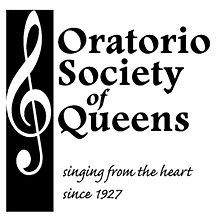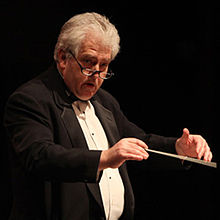- Oratorio Society of Queens
-
The Oratorio Society Of Queens 
Oratorio Society of Queens logoBackground information Origin Queens, New York, United States Genres Choral Occupations Community Chorus Years active 1927-present Website www.QueensOratorio.org Members Artistic Director & Conductor
David Close
Assistant Conductor
Benjamin Arendsen
Assistant to the Conductor
Barbara PodgurskiThe Oratorio Society of Queens is a non-profit membership organization which performs the great choral masterpieces and is the oldest performing arts institution in the borough of Queens, NY. David W. Close is the Artistic Director and Conductor.
Established in 1927 by Flushing, NY folks who loved to sing, the Oratorio Society of Flushing was Queens’ answer to the prestigious Oratorio Society of New York, founded 54 years earlier. Without the acoustics and grandeur of Carnegie Hall, the Oratorio Society of Flushing brought the best of classic choral music across the East River into Queens. Its inception preceded the completing of the subway (the #7 line) in 1931 and the building of the Triboro Bridge in 1940. Through the "Great Depression" and World War II, the chorus continued to rehearse and perform, contributing to the stability of Queens and New York City by helping us all to live "life as usual" in the most extraordinary of times. As the population of Queens grew and prospered, so did the Oratorio Society of Flushing and in 1985 the Society incorporated as the Oratorio Society of Queens (OSQ), reflecting the expanding participation of voices from neighborhoods beyond Flushing. Today the membership is borough-wide and even includes several Bronx and Nassau County residents.
OSQ is a charter member of both the Queens Council on the Arts and the Flushing Council on Culture & the Arts. Throughout its history, OSQ has been non-sectarian and to this day welcomes adult members of all ages, faiths, and ethnicities. The roster of members invariably includes active and retired educators, lawyers, health professionals, Wall Street executives, engineers, homemakers, secretaries, writers, librarians, actors, artists and students - in short, people from all walks of New York City life.
Contents
History
The Oratorio Society of Queens, originally known as the Oratorio Society of Flushing, was founded in 1927. The idea of a community-based mixed voice chorus, dedicated to sharing the aesthetic values oratorio music expresses, was conceived by Mrs. Edward Keefe as Queens' answer to the Oratorio Society of New York. Mrs. Keefe was initially assisted by John W. Norton, organist and choirmaster of St. George's Episcopal Church and Edward M. Franklin, a leading layman of the church.
The charter members were an enthusiastic and dedicated group drawn from Flushing's several old, prominent families, among the most esteemed and respected in New York City. In keeping with the democratic spirit historically associated with Flushing, membership was open to all. Among other members was Bertha Parsons, the last owner-resident of John Bowne House before it was opened as a museum of early Flushing. On May 12, 1927 a chorus of 100 voices directed by John Norton performed Mendelssohn’s "Hymn of Praise" to critical acclaim before an audience of 900 at Flushing High School. The Society's characteristic feeling of good fellowship and loyalty started at inception and continued throughout.
There would be carol singing at Flushing Hospital, after which the singers would sing at a founder's home and partake of a lovely party in the festively decorated house. Local merchants provided financial support and articles for door prizes at fundraising events. The Society was supported by member dues, subscribers, bake sales and fundraising dinners. Mrs. Maude Wilson was made an honorary member in the early 1930s because she contributed the entire proceeds of her Annual Party and Dahlia Flower Show to the Society. Fundraising was always a necessity even though concert accompaniment was originally by organ or piano.
The chorus, subsequently conducted by Herbert Stavely Sammond, and later by Lawrence Rasmussen, performed two major concerts a year until 1943, when Mr. Rasmussen was called to service in World War II. Rehearsals were suspended until 1946 when Mr. Rasmussen returned. David Katz (founder of the Queens Symphony) succeeded Mr. Rasmussen in ensuing years, dispelling the notion that the works of the great masters are too deep and profound for the average person to understand and appreciate. By OSQ's seventy-fifth anniversary in 2003, Maestro David Close had, for thirty-five years, successfully continued the traditions established by the founding members.
The expansion to full orchestra accompaniment with professional vocal soloists created the need for increased funding. Although continuing its annual Fundraising Dinner each April, OSQ depends upon grants from corporate and public funds in addition to traditional ticket sales and subscriptions.
In 1985, the Society changed its name to the Oratorio Society of Queens in recognition of membership deriving from all parts of Queens. The entire Borough was learning that one need not travel to Manhattan for classical music, one could go to The Performing Arts Center at Queensborough Community College, St. Andrew Avellino Church, the Reformed Temple of Forest Hills, Trinity Lutheran Church, Christ the King High School, Flushing Meadows - Corona Park under the Unisphere, Seuffert Bandshell in Forest Park, Bayside High School, Colden Center or various venues in Brooklyn and Long Island. The Society appeared at the 1940 World’s Fair and in later years at Lincoln Center.
Notable members
- Harold Friedell, an organist for Oratorio Society concerts, was a noted composer of religious music and is published in current hymnals.
- Margaret Harshaw, contralto, became a Metropolitan Opera singer.
- Penelope Daner, soprano, became a world-renown singer singing at La Scala, Milan, the Metropolitan Opera in New York City and The Lyric Opera of Chicago.
- Patricia ("Patti Jo") Stevens, soprano and former mezzo-soprano, made her New York City Opera debut in 2002.
- John Easterlin, tenor, has become a world-renown singer recently singing at The Lyric Opera in Chicago.
- Gregory Hopkins, tenor, has sung leading roles in the New York City Opera.
- Cornelius L. Reid, baritone, became a leading voice teacher in New York City with a number of books published to his credit.
- Judith Somogi was the pianist for Oratorio Society concerts in the mid-1950s. She became a New York City Opera conductor.[1]
- Maestro David Katz founded the Queens Symphony Orchestra.
- Maestro David Close founded the Orchestral Arts Ensemble of Queens and Musica Reginae Productions.
Awards and honors
- Charter Member of the Queens Council on the Arts 1967
- Certificate of Appreciation from the Queens Borough Public Library to David Close & the Flushing Oratorio Society (sic) for a presentation at a Holiday Program at the Hillcrest Branch, April 4, 1985
- Certificate of Appreciation from the Flushing Council on Culture and the Arts to the Oratorio Society of Flushing - its 1983 Award for Achievement, 12/8/82
- Congressional Record - Hon. Gary L. Ackerman 1987: "In these times when materialism seems to take precedence over many of the esthetic aspects of society, it is most important that the arts and the needs of the human spirit are not neglected. Through the fine efforts of the Oratorio Society of Queens, we may be sure that it will not be."
- Congressional Record - Hon. Gary L. Ackerman 2002
- Letters from Debra Markell-Kleinert, Queens Borough Director, Community Assistance Unit and from Michael Bloomberg, Mayor of the City of New York “ welcoming everyone to Queensborough Community College for the 75th Holiday Concert of the Oratorio Society of Queens, 12/22/02"
Conductors
- Spring 1927 = John Norton
- Winter 1927 = Dr. Clarence Dickinson
- Spring 1928 - Spring 1938 = Herbert Stavely Sammond
- Winter 1938 - Spring 1952 = Lawrence Rasmussen
- Winter 1952 - Winter 1953 - No conductor
- Spring 1954 - Spring 1956 = Donald Comrie
- Winter 1956 - Spring 1959 = Frederick Heyne
- Winter 1959 - Winter 1961 = Elizabeth DeMartini
- Spring 1962 - Spring 1963 = James McEvers
- Winter 1963 - Spring 1968 = Warren H. Brown
- Winter 1968 - Winter 1969 = David Katz
- Spring 1970–Present = David Close
References
External links
Categories:- Choral societies
- Non-profit organizations based in New York
- Musical groups from Queens
Wikimedia Foundation. 2010.


